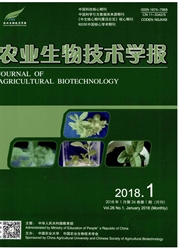

 中文摘要:
中文摘要:
为了探究生长激素受体(growth hormone receptor,GHR)在牦牛(Bos grunneins)不同组织中的表达情况,本研究采集牦牛不同组织(心脏、肝脏、脾脏、肺脏、肾脏和睾丸)作为实验样品,实时荧光定量PCR(quantitative Real-time PCR,qRT-PCR)测定GHR基因在不同组织中的相对表达量;免疫组织化学法(immunohistochemistry,IHC)检测GHR蛋白在不同组织中的分布及定位,测定并分析阳性反应物的积分光密度.qRT-PCR结果表明,GHR基因在牦牛不同组织中的表达存在差异性,肝脏中的相对表达量最高,分别是心脏、肾脏、睾丸、肺脏和脾脏中的3.73、4.98、5.03、8.58和10.21倍;免疫组织化学结果显示,GHR蛋白在肝脏、心脏、肾脏、睾丸、肺脏和脾脏中均有分布,阳性反应强度不等,对比分析积分光密度值得出,肝脏中GHR蛋白的表达最高,心脏、肾脏、睾丸和脾脏次之,肺脏中最少.本实验在基因水平和蛋白水平表明GHR在牦牛不同组织中的表达具有差异性,为牦牛的改良和育种提供了一定的理论资料.
 英文摘要:
英文摘要:
To explore the expression of growth hormone receptor (GHR) in different tissues of yak(Bos grunneins), samples of these tissues (heart, liver, spleen, lung, kidney and testis) were collected from healthy yaks under normal physiological conditions. Quantitative Real-time PCR (qRT-PCR) was applied to analyze the expression of GHR gene in different tissues. Immunohistochemistry (IHC) was used to detect the distribution and localization of GHR protein, integrated optical density (IOD) of GHR immunoreactions were measured, and followed by an analysis for significant difference. The results of qRT-PCR showed that GHR gene had a differential expression in different tissues, comparative expression quantity of GHR gene in liver was 3.73 fold than that in heart, 4.98 fold in kidney, 5.03 fold in testis, 8.58 fold in lung and 10.21 fold in spleen, respectively. Unequal immunoreaction intensity was observed in different tissues by immunohistochemistry. Comparative analysis of IOD showed that GHR had the strongest immunoreactions in liver, and followed by the heart, kidney, testis and spleen, the weakest immunoreactions of GHR was found in lung. This experiment demonstrated that GHR had a differential expression in different tissues by studying at genetic and protein level. This work provides a theoretical information for improvement and breeding of yak.
 同期刊论文项目
同期刊论文项目
 同项目期刊论文
同项目期刊论文
 期刊信息
期刊信息
